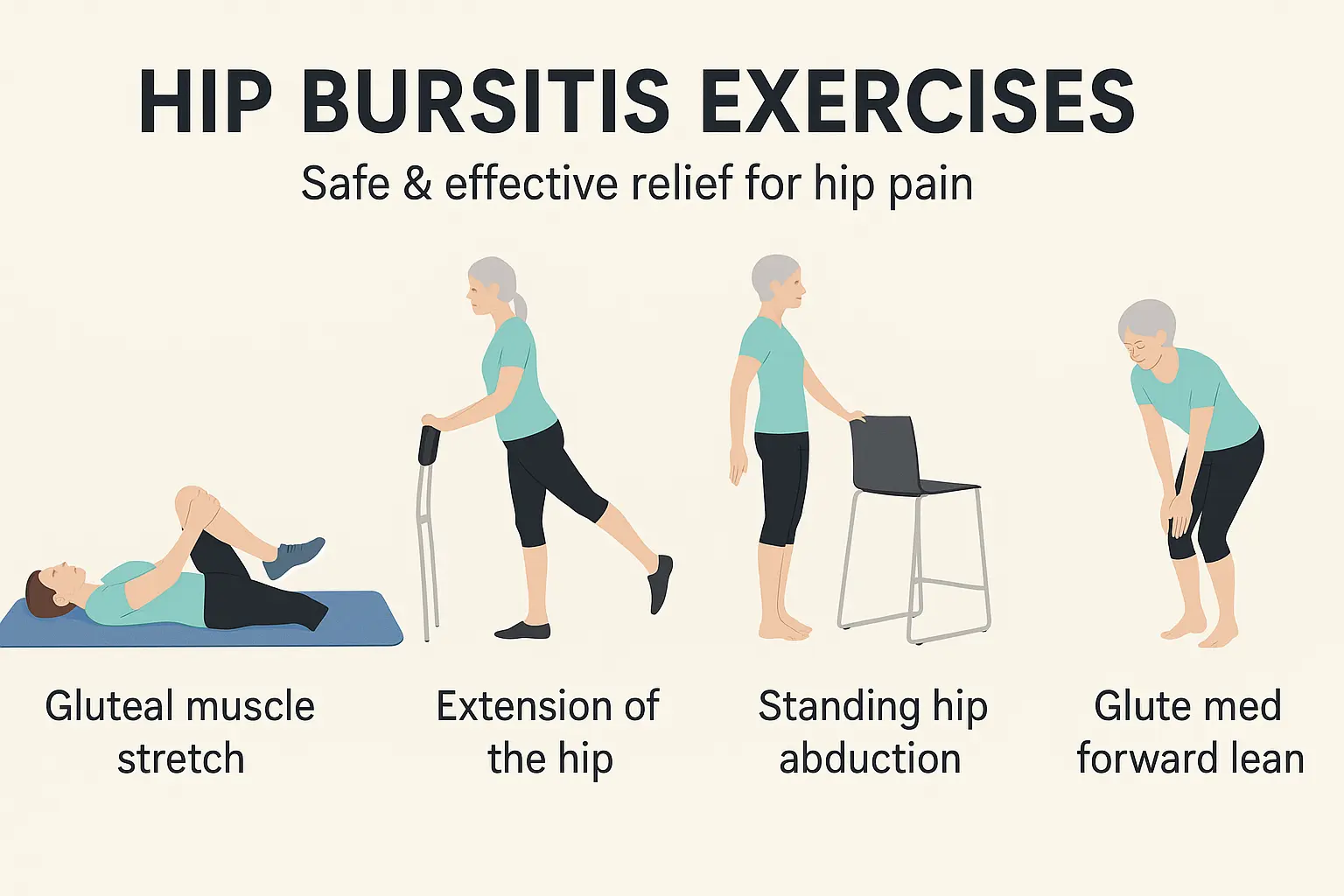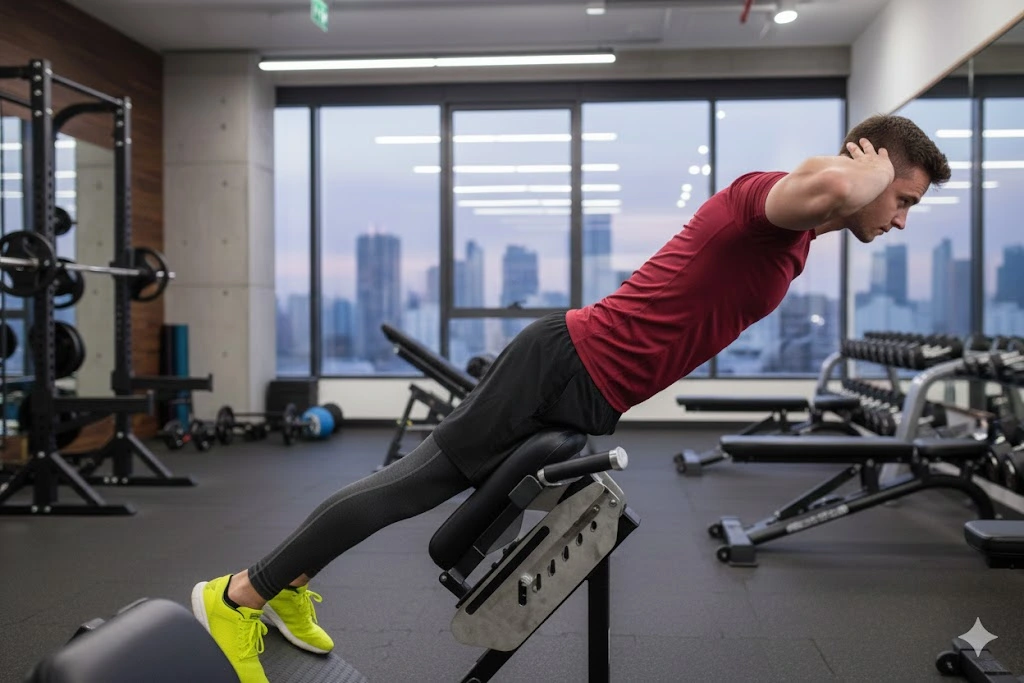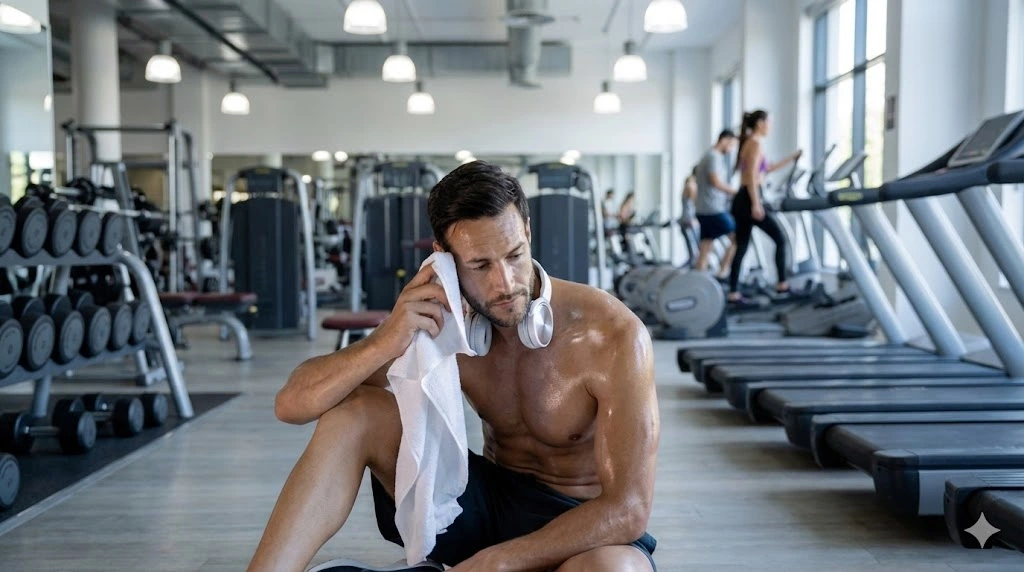Introduction to Hip Bursitis
Hip bursitis happens when the small fluid-filled sacs around the hip joint, called bursae, become inflamed. Mayo Clinic – Bursitis Overview These sacs normally act as cushions to reduce friction, but when irritated, even simple movements like walking, running, or sitting for extended periods can cause sharp discomfort.
This condition is especially common among runners, walkers, and people with desk jobs who sit for extended periods. If left untreated, the pain can worsen and limit daily activities. Hip bursitis exercises are one of the safest and most effective ways to manage this condition naturally. Just like our guide on Best Bodyweight Exercises to Get Strong, these routines help you build strength without stressing the joints.
It’s also important to know what makes bursitis worse. Activities like prolonged sitting, frequent stair climbing, or sleeping on the affected side can all aggravate the pain. By avoiding these triggers and committing to gentle, targeted exercises, you can speed up your recovery and protect your hip joints in the long run.
Table of Contents
Understanding Hip Bursitis Pain & Triggers
The pain from hip bursitis is usually felt on the outer side of the hip, where the bursa becomes inflamed. Many people describe it as a sharp or burning sensation that can worsen when lying on the painful side, climbing stairs, or even after sitting for too long. In some cases, the hip may also feel tender or swollen to the touch.
There are several common causes behind hip bursitis. Repetitive movements, such as running or cycling without proper form, can irritate the bursa. Weak glute muscles and poor posture often place extra strain on the hip, while sudden injuries, like a fall, may trigger inflammation as well. People who sit for long hours or stand on hard surfaces regularly are also at higher risk.
Certain groups are more likely to experience hip bursitis. Women, middle-aged and older adults, and athletes are especially vulnerable due to body mechanics and repetitive stress on the hip joint. It’s important to note that hip bursitis is not the same as arthritis or tendonitis. While arthritis affects the joint itself, tendonitis affects the tendons, and bursitis specifically involves the inflammation of the cushioning sacs.
General Rehab Principles
Before starting any hip bursitis exercise program, it’s important to follow a few basic rehabilitation principles. These guidelines ensure that your exercises are safe, effective, and actually help your hip recover instead of making the pain worse.
The first rule is to start slow and progress gradually. In the beginning, stick with gentle stretches and low-intensity strengthening exercises. As your pain decreases and mobility improves, you can slowly add more challenging moves.
Another key principle is to listen to your body and use the pain scale as a guide:
- Pain levels between 0–3 are considered safe.
- 4–5 is acceptable but requires caution.
- Anything from 6–10 means you should stop or modify the exercise immediately.
When it comes to frequency, stretching should be done 2–3 times per day, while strengthening exercises are usually performed 1–2 times daily, depending on your tolerance. Remember: consistency is more important than intensity.
It’s also best to avoid lying on the painful hip, as this puts direct pressure on the inflamed bursa. Combine exercises with RICE therapy (Rest, Ice, Compression, Elevation), posture correction, and supportive footwear to achieve optimal results. Our guide on Gym Essentials for Men highlights supportive gear that can also reduce unnecessary strain. These small adjustments can make a big difference in your healing journey.
Stretching Exercises for Hip Bursitis
Stretching is one of the most effective ways to relieve stiffness and restore mobility when dealing with hip bursitis. By gently lengthening tight muscles around the hip, you can reduce pressure on the inflamed bursa and prevent muscle imbalances that often worsen the condition.
Here are some of the most recommended stretching exercises for hip bursitis:
- Piriformis Stretch – Sit on a chair, place one ankle over the opposite knee, and lean forward gently until you feel a stretch in your outer hip. This helps release tension in the piriformis muscle, which often contributes to hip pain.
- Iliotibial (IT) Band Stretch – Stand upright and cross one leg behind the other. Lean toward the unaffected side while keeping your hips forward. You should feel the stretch along the outside of your hip and thigh.
- Seated Hip Stretch – Sit on the floor with one leg straight and the other bent so that your foot crosses over the opposite knee. Gently twist your torso toward the bent leg to stretch the hip and glutes.
- Double Knee-to-Chest Stretch – Lie on your back and bring both knees toward your chest, holding them with your hands. This stretch helps release the lower back and hip area at the same time.
When performing these stretches, hold each one for 15–30 seconds, repeat 2–4 times, and aim to stretch daily. Always warm up slightly before stretching, and never push into sharp pain.
Strengthening Exercises for Relief
Strengthening exercises are the real foundation for long-term hip bursitis recovery. If you’re training at home, using a Workout Bench with Weights can make these routines even more effective. Strong muscles around the hip provide better stability, reduce pressure on the bursa, and lower the chances of flare-ups in the future.
Here are the most effective strengthening routines:
Beginner Level
- Clamshells – Lie on your side with knees bent, keeping feet together. Slowly lift the top knee while keeping hips steady. Progress by adding a resistance band or moving into a side plank clamshell.
- Straight Leg Raises – Lie on your back, keep one leg straight and the other bent. Slowly raise the straight leg, hold briefly, then lower it back down.
- Side-Lying Hip Abduction – Lie on your side with legs straight. Lift the top leg upward without rotating the hips. This move targets the gluteus medius, a key stabilizer muscle.
- Glute Bridges – Lie on your back with knees bent and feet flat on the ground. Lift your hips upward, squeezing the glutes at the top. Hold for a few seconds before lowering.
Intermediate & Advanced
- Prone Hip Extension – Lie face down, tighten your glutes, and slowly lift one leg upward without arching your lower back.
- Wall Squat with Ball – Place a stability ball against the wall and squat slowly, keeping the movement partial to avoid irritation.
- Step-Ups – Step onto a stable platform or step, focusing on controlled movements and proper alignment.
- Side Plank & Plank – Builds hip and core stability to protect the joints during movement.
- Lying Leg Circles – Lie on your back and lift one leg slightly. Move it in small circles to challenge hip control and mobility.
These bursitis hip exercises should be done slowly and with proper form. Start with 10–12 reps per set, repeating 2–3 times, and increase gradually as your strength improves.
Functional & Low-Impact Conditioning
Once you’ve built a foundation with stretching and strengthening, the next step is to add functional and low-impact conditioning exercises. These activities train your hip to handle everyday movements without irritation while improving endurance and mobility.
Some of the best options include:
- Walking – Begin with flat, even surfaces. Avoid hills or inclines at first, since they put extra stress on the hip. Start with short sessions and gradually increase the distance.
- Aquatic Therapy (Water Walking) – Exercising in water reduces body weight pressure on the hips, making it easier to move without pain. Water also provides gentle resistance to build strength safely.
- Stationary Cycling – is excellent for maintaining mobility and cardiovascular fitness. Pair it with our 30-Day Muscle Building Workout for safe progress..
- Gentle Yoga & Tai Chi – These practices help improve posture, balance, and flexibility while keeping the movements smooth and controlled.
A key principle during this stage is the 10% rule: increase your activity level by no more than 10% each week. If you feel pain or stiffness the next day, it means you pushed too far. Adjust accordingly and return to a level where your hip feels comfortable.
This stage is essential for transitioning from basic rehabilitation to regular daily activity. By combining conditioning with stretching and strengthening, you’ll give your hip the best chance to heal fully while preventing future flare-ups.
Trochanteric Bursitis Exercises & Stretches
Trochanteric bursitis is a specific type of hip bursitis (NIH – Trochanteric Bursitis Research) that affects the outer side of the hip, where the greater trochanter bone meets the bursa. This condition often causes pain when lying on the affected side, walking upstairs, or even during simple daily activities. The good news is that a combination of targeted exercises and stretches can provide significant relief.
Effective Trochanteric Bursitis Exercises
- Hip Abduction with Resistance Band – Place a resistance band just above your knees, stand tall, and slowly move one leg out to the side. This strengthens the gluteus medius, which stabilizes the hip.
- Wall Squats – With your back against a wall, bend your knees slightly into a mini squat position, hold, then rise back up. This builds strength in the thighs and glutes without overloading the hip.
- Side-Lying Leg Raises – Similar to general hip abduction, but especially useful for outer hip strengthening.
Trochanteric Bursitis Stretches
- IT Band Stretch – Cross one leg behind the other and lean away from the affected hip. This relieves tightness in the IT band, which often contributes to outer hip pain.
- Glute Stretch (Figure-4 Stretch) – Lie on your back with one ankle crossed over the opposite knee. Pull the lower leg toward your chest until you feel a stretch in the outer hip and glutes.
By combining strengthening and stretching, you address both sides of the problem: weak muscles that fail to stabilize the hip and tight tissues that pull on the bursa. For best results, perform these exercises 3–4 times per week, and always avoid pushing into sharp pain.
Phased Exercise Plan
Recovering from hip bursitis is not just about doing random stretches and strengthening moves, it’s about following a phased approach that matches the stage of your healing. This ensures that your hip gets the right amount of support at the right time without risking further irritation.
Phase 1: Acute / Painful Stage
- Focus on reducing inflammation and avoiding aggravating activities.
- Gentle stretches such as the piriformis and IT band stretch.
- Isometric contractions (tightening the glutes without moving the joint).
- Short glute bridges and very light clamshells if tolerated.
Phase 2: Recovery Stage
- Gradually introduce controlled strengthening.
- Glute bridges with longer holds.
- Side-lying hip abduction.
- Prone hip extensions.
- Partial wall squats
Phase 3: Return to Activity
- Begin adding more functional exercises.
- Step-ups to mimic daily stair use.
- Planks and side planks to enhance core and hip stability.
- Light cardio such as flat-surface walking or low-resistance cycling.
Phase 4: Maintenance & Prevention
- Aim for a long-term routine to keep your hips healthy.
- Continue daily stretching for flexibility.
- Strength training 2–3 times per week for stability.
- Include balance and posture-focused exercises like yoga or tai chi.
Lifestyle Tips
Exercises are the foundation of recovery, but your daily lifestyle habits also play a huge role in how quickly and effectively your hip heals. Small adjustments can prevent flare-ups and make your rehabilitation routine more effective.
Lifestyle Tips for Healing Hip Bursitis
- Posture Correction – Avoid slouching while sitting. Keep feet flat, hips even, and consider using a cushion for support.
- Sleeping Position – If you’re a side sleeper, place a pillow between your knees to reduce pressure. Always avoid lying directly on the painful hip. A medium-firm mattress offers the best support.
- Heat & Ice Therapy – Use ice packs during flare-ups to calm inflammation and heat packs when stiffness sets in.
- Activity Pacing – Break up long periods of sitting or standing. Avoid climbing stairs repeatedly or walking on uneven surfaces until your hip is stronger.
- Footwear Matters – supportive shoes reduce impact and improve alignment, lowering stress on the hips. Recovery also depends on nutrition—check our guide to the Best Protein Powders 2025 to support muscle healing.
Frequently Asked Questions (FAQs)
Q1. What aggravates hip bursitis?
Overuse, prolonged sitting, climbing stairs, lying on the affected side, and wearing unsupportive shoes can all make it worse.
Q2. How often should I do hip bursitis exercises?
Stretching can be done 2–3 times daily, while strengthening exercises are safe 1–2 times a day, depending on your tolerance.
Q3. Can I sleep on my side with hip bursitis?
Yes, but only if you place a pillow between your knees and avoid lying directly on the painful hip.
Q4. Should I stop exercising if I feel pain?
Mild discomfort (pain level 0–3) is safe, but sharp pain means you should stop or modify the movement.
Q5. How long until exercises help hip bursitis pain?
Most people notice improvements within 4–6 weeks with consistent stretching and strengthening.
Q6. Can hip bursitis return after recovery?
Yes, if lifestyle factors like poor posture, weak muscles, or overuse aren’t corrected. Maintenance exercises are essential.
Conclusion & Call-to-Action
Hip bursitis may cause frustrating pain and stiffness, but with the right approach, recovery is very achievable. The combination of stretching, strengthening, and functional conditioning gives your hip the support it needs to heal and stay healthy. Remember, consistency matters more than intensity, gentle daily exercises will do far more good than pushing yourself too hard.
Simple adjustments in posture, sleeping position, and activity pacing can protect your hips in the long run. Adding Bodyweight Exercises as part of your routine helps maintain strength and joint health. By making these habits part of your daily routine, you’ll not only manage hip bursitis but also improve your overall joint health.
If pain persists or worsens despite regular exercises, it’s always best to consult a physiotherapist for a personalized treatment plan. Everyone’s body is different, and professional guidance can ensure your recovery is both safe and effective.






5 Responses
I wanted to thank you for this great read!! I definitely enjoying every little bit of it I have you bookmarked to check out new stuff you post…
Thankyou for all your efforts that you have put in this. very interesting info .
I have been absent for a while, but now I remember why I used to love this blog. Thank you, I will try and check back more often. How frequently you update your website?
Thanks a bunch for sharing this with all of us you actually know what you are talking about! Bookmarked. Please also visit my web site =). We could have a link exchange arrangement between us!
Excellent read, I just passed this onto a friend who was doing some research on that. And he actually bought me lunch because I found it for him smile So let me rephrase that: Thank you for lunch! “The capacity to care is what gives life its most deepest significance.” by Pablo Casals.